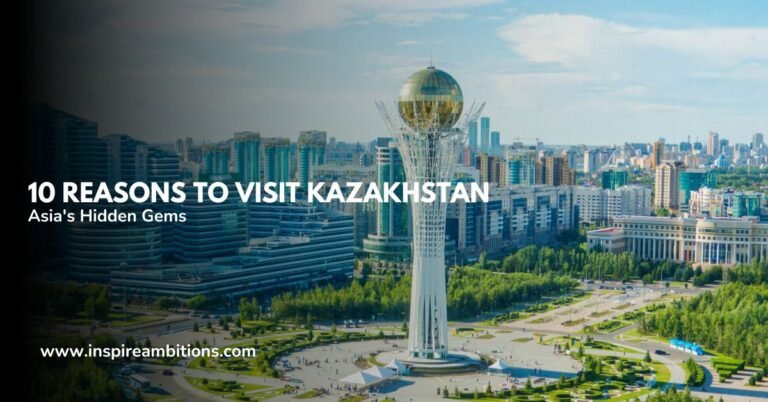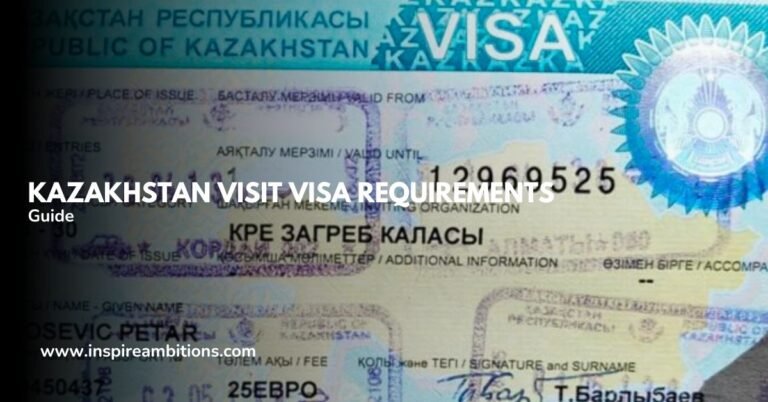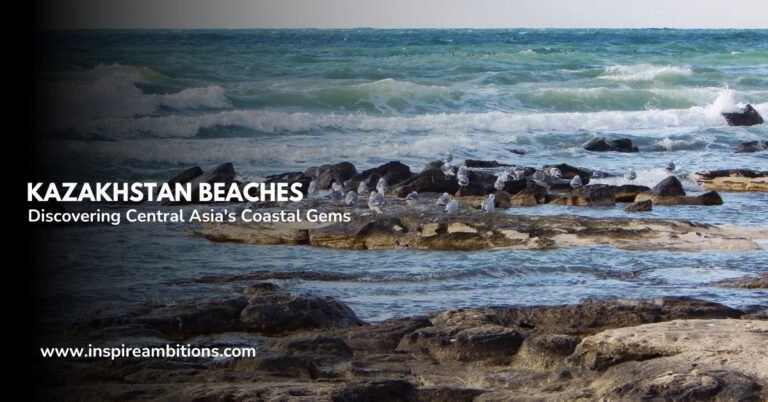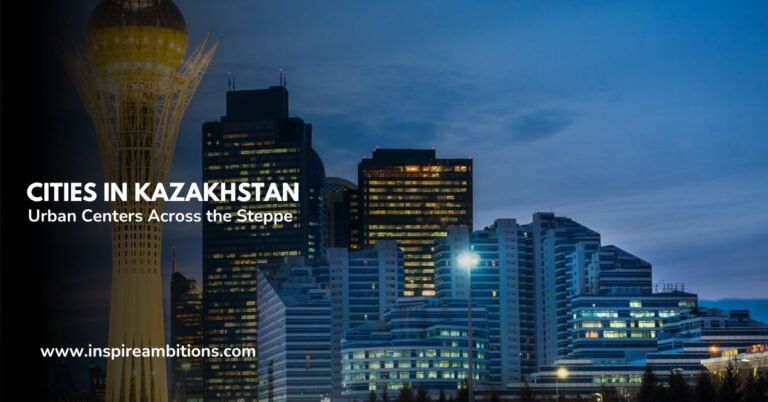Meilleur moment pour visiter le Kazakhstan – Un guide de voyage saisonnier
Planning a visit to Kazakhstan involves considering the expansive country’s diverse climates, which vary widely across its vast territory.
As the ninth largest country in the world, Kazakhstan offers a wealth of experiences depending on when you visit. The climate ranges from arid and continental to extreme seasonal fluctuations in certain regions, dictating the best times to enjoy all Kazakhstan offers.
Travellers can experience everything from the blooming landscapes of spring to the crisp, snowy winters.
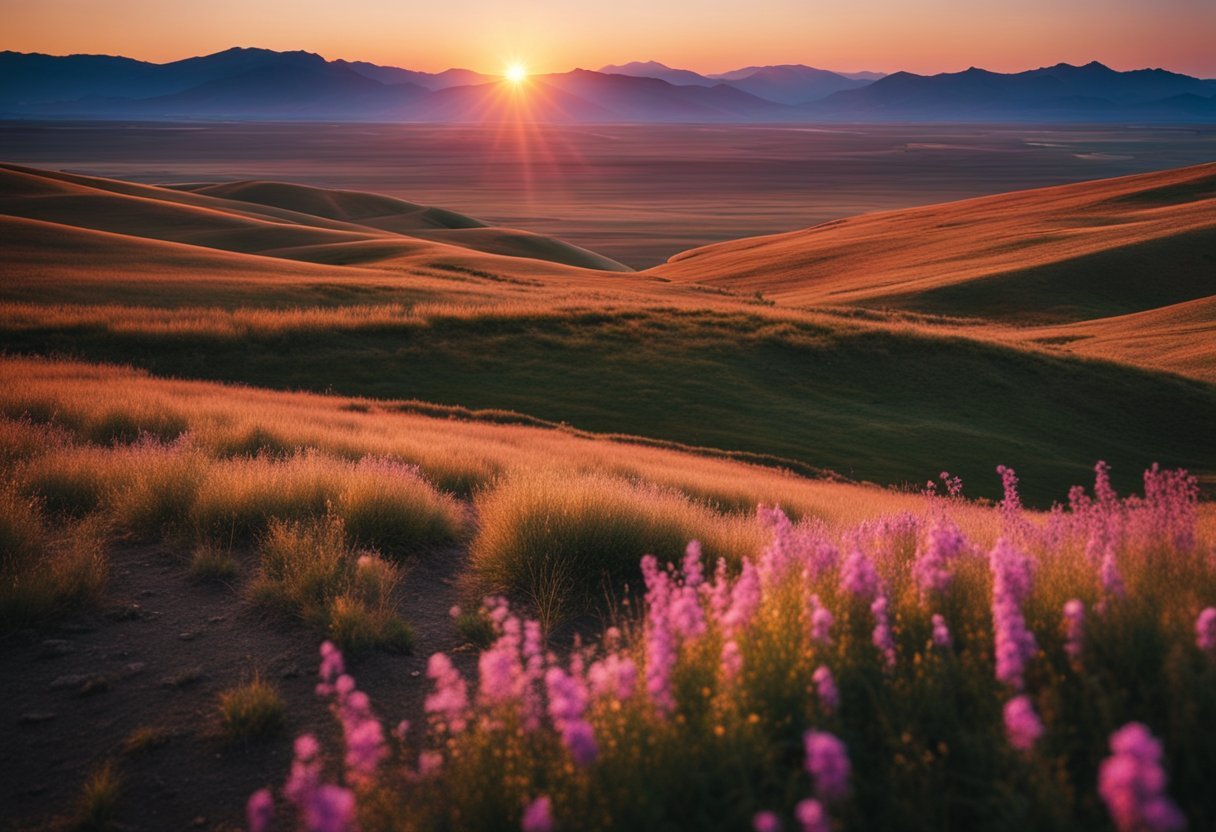
Timing your visit for cultural experiences and festivals is crucial to immerse yourself in Kazakhstan’s rich traditions. Spring and autumn are particularly rewarding for those looking to explore the country without the extreme heat of summer or the biting cold of winter.
However, for adventurers and outdoor enthusiasts, the peak summer months provide an opportune time to explore the natural beauty of Kazakhstan’s mountains, steppes, and lakes under warmer temperatures.
Best Time to Visit Kazakhstan – Key Takeaways
- Optimal travel times in Kazakhstan vary by activity and region.
- Spring and autumn offer moderate climates for cultural explorations.
- Le summer months are ideal for outdoor adventures.
Climatic Variations Across Kazakhstan

Kazakhstan exhibits a range of climatic variations, characterised by distinct temperature changes and precipitation levels as the seasons transition. The country’s vast size contributes to regional differences in weather patterns, making each season unique.
Spring in Kazakhstan
In Kazakhstan, the spring months, March to May, bring a from March to May, from approximately 2°C in March to about 20°C in May. Precipitation increases, especially in April and May, offering a reprieve from the dry weather of winter.
Summer in Kazakhstan
Pendant Juin, juillet et août, Kazakhstan experiences its peak of warmth. July and August witness fluctuating temperatures ranging from 15°C to 30°C. These months afford all outdoor activities owing to the generally dry climate and longer daylight hours.
Autumn in Kazakhstan
Autumn transitions the landscape with cooler climes prevailing. Septembre à novembre sees daytime temperatures dip from 20°C in early autumn to below 0°C in late November. While the early autumn is relatively dry, there is increased precipitation as one progresses towards winter.
Winter in Kazakhstan
Le winter months of December to February are identified by notably cold temperatures, with averages dropping as low as -20°C. Weather conditions are harsh, encompassing substantial snowfall and below-freezing temperatures, though there is less humidity than in other seasons.
Regional Highlights and Ideal Seasons

Dans planifier un voyage to Kazakhstan, one must consider the diversity of its landscapes and climate. Whether you’re drawn to the vast steppes or the bustling modern cities, each region offers its ideal travel season for visitors to immerse themselves in the natural beauty and cultural experiences.
The Steppes and Northern Kazakhstan
The vast expanse of the steppes is enchanting during the late spring months of April to June when the grasslands are lush, and the weather is mild.
Travellers can explore the great outdoors without the extreme temperatures found in the height of summer or the depths of winter. The region’s famed Altyn Emel National Park is exceptionally splendid in spring with its singing dunes and rocky formations.
Almaty and the Tian Shan
Almaty, nestled at the foot of the majestic Tian Shan mountains, is a hub for cultural and outdoor activities. The optimal time to visit is between April and May for spring’s floral display or during September and October when the golden hues of autumn set the city aglow.
This period brackets the hot summer while avoiding the harsh winter, providing ideal conditions for sightseeing and hiking in the nearby mountains.
Astana, the Modern Capital
Astana (now known as Nur-Sultan), Kazakhstan’s modern capital, shines in the summer months from Juin à août. The city’s futuristic architecture and the variety of international festivals are best enjoyed when the temperatures are warm but not overly hot and the days are long.
During these months, the city’s numerous parks and riverside promenades are lively with locals and tourists alike.
The Caspian Sea Coastline
Le Caspian Sea coastline, with its unique landscapes and biodiversity, beckons visitors during the warm and pleasant climate of late spring and early summer (May to early July) or during the tranquil onset of autumn in Septembre.
These times allow for the enjoyment of coastal activities before the peak heat of summer or the chilly winds of late autumn and winter descend upon the region.
By understanding each region’s distinct seasons and attractions, travellers can tailor their itineraries to maximise their experience in Kazakhstan’s varied landscapes.
Best Times for Cultural Experiences and Festivals
Kazakhstan offers a rich tapestry of cultural experiences and festivals throughout the year. For travellers interested in immersing themselves in local traditions and national celebrations, certain months provide a window into Kazakhstan’s vibrant heritage.
National Celebrations
Nowruz marks the Persian New Year and heralds the onset of spring. Celebrated on March 21st, it’s a festive time that showcases colourful events, traditional foods, and folk music. It is a public holiday renowned for its community spirit and joyous celebrations.
Victory Day, observed on May 9th, is a momentous occasion commemorating the end of World War II. Visitors can expect military parades and expressive public gatherings, reflecting Kazakhstan’s national pride and historical resilience.
Kazakhstan Nations Unity Day, celebrated on May 1st, is an occasion that promotes harmony and understanding among the diverse cultures within Kazakhstan. Festivities on this day often include cultural exhibitions and folk concerts.
Local Festivities and Traditional Events
Le Silk Road Festival occurs several days in June, celebrating Kazakhstan’s historical role as a trade and cultural crossroads between Asia and Europe. It features a kaleidoscope of music, dance, and craftsmanship, ideal for cultural enthusiasts.
Local festivities often include traditional events that showcase horse riding, falconry, and regional gastronomy. These events occur throughout the year, especially during the summer months of July and August, when the weather is warm and conducive to outdoor activities.
Outdoor Activities and Adventure Timing
Kazakhstan’s diverse landscapes offer optimal conditions for a variety of outdoor activities. To experience these at their best, timing is critical, with specific periods of the year enhancing the enjoyment and feasibility of these adventures.
Mountain Excursions
The mountains of Kazakhstan are prime for excursions, especially in the warm summer months of July and August. During this period, temperatures are favourable for both hiking and trekking, with trails more accessible. For winter sports enthusiasts, ski resorts like Shymbulak welcome visitors between November and April, where skiing conditions peak due to steady snowfall.
Water Sports and Fishing
Water sports such as rafting and kayaking are best enjoyed from late spring to early autumn, ensuring the rivers are at optimal levels. Specifically, the Ili River near Preserve Balkhash is a notable spot for fishing enthusiasts, with late April to October being the ideal months to cast a line.
Wildlife and Nature Tours
Nature tours to witness Kazakhstan’s wildlife, including the practice of eagle hunting, are optimal in the milder seasons of spring and autumn. This is when animals are most active and visible in their natural habitats. Moreover, venues for équitation et cycling through the scenic outdoors are at their best from May through September, offering pleasant weather for extended tours.
Travel Tips for Kazakhstan
When planning a journey to Kazakhstan, travellers should pay close attention to visa requirements, transportation options, and accommodation booking strategies to ensure a smooth trip.
Visa and Documentation
Travellers must ensure they have all necessary documentation before arriving in Kazakhstan. While some nationalities can avail themselves of visa-free entry for a limited period, others may need to obtain a visa in advance. It is advisable to check the latest regulations from the official Kazakhstan visa portal and ensure that passports are valid for at least six months beyond the intended stay.
Transport Options and Distances
Kazakhstan’s vast landmass means that distances between major cities and attractions can be significant. Travellers should consider multiple transport options:
- Les trains: A reliable and scenic way to traverse large distances.
- Domestic flights: Efficient for covering vast distances quickly.
- Les autobus: Cost-effective and suitable for shorter distances.
- Car rental: Offers flexibility, but one must be prepared for long drives.
Travel by train is a popular choice, with routes connecting major cities such as Astana and Almaty, which can be viewed on the Kazakhstan Railways website.
Conseils en matière d'hébergement et de réservation
Booking accommodation in advance is prudent, especially during peak summer tourism and winter ski season. Travellers have a range of options, from luxury hotels to guesthouses and hostels:
- Hôtels de luxe offer comfort and amenities but book early for the best rates.
- Guesthouses: Provide local experiences, often with home-cooked meals.
- Hostels: Ideal for budget travellers and usually centrally located.
Utilising online booking platforms can help secure the best deals and ensure availability. One may also consider recommendations from a trusted travel guide for specific areas that align with one’s travel plans.
Considerations for Safety and Comfort
When planning to travel to Kazakhstan, it is essential to consider health precautions and understand the local customs to ensure a safe and comfortable experience. Visitors should be prepared for the country’s varying climates and respect the cultural norms to enjoy their stay.
Health and Medical Precautions
Travellers should ensure they have comprehensive assurance voyage that covers medical expenses. Visiting a travel clinic for necessary vaccinations and health advice specific to Kazakhstan several weeks before departure is advisable.
Carrying a basic first-aid kit and knowledge of local emergency numbers is also recommended. In the larger cities, medical facilities are adequate but may not always meet Western standards, especially in rural areas.
Remember that environmental factors such as the arid climate in certain regions can pose a risk of dehydration; hence, carrying ample eau et sun protection is essential. The temperature can drop significantly in the winter, making warm clothing and awareness of weather conditions crucial to avoid hypothermia or frostbite.
Cultural Etiquette and Customs
Kazakhstan is a nation with deep cultural traditions that one must respect to ensure a harmonious visit—formal greetings are every day, with a handshake generally acceptable. However, males should wait for a female to extend her hand first. Titles and surnames are typically used upon first meeting.
When invited to a Kazakh home, bringing a small gift and removing one’s shoes before entering is polite. Dressing conservatively is recommended to respect local sensibilities, particularly in religious and rural areas.
En lisant books about Kazakhstan before travelling can offer insights into intricate customs like table etiquette and the traditional Kazakh sauna, or ‘banya’, an experience not to be missed yet approached with cultural awareness.
Understanding and observing these health precautions and cultural nuances will contribute to a safe, respectful, and enriching visit to Kazakhstan.
Photography and Unique Kazakh Encounters
Kazakhstan’s vast and diverse landscapes offer photographers an exceptional backdrop, while cultural enthusiasts can engage in unique activities to fully immerse themselves in the Kazakh way of life.
Scenic Locations for Photography
Kazakhstan abounds with picturesque locations suited for photography enthusiasts. The Big Almaty Gorge is a must-visit site, providing dramatic mountain vistas perfect for landscape shots.
Meanwhile, for those interested in capturing the essence of human triumphs in science and exploration, the Baikonur Cosmodrome is an iconic subject with a deep history of space exploration. For ancient petroglyph photography, travellers should venture to Tamgaly Tas, where profound rock carvings rest against the natural canvas of the Ili River.
- Big Almaty Gorge: Capture the serene beauty of turquoise lakes surrounded by snow-peaked mountains.
- Baikonur Cosmodrome: Document the operational space launch facility’s history of space endeavours.
- Tamgaly Tas: Focus your lens on the ancient carvings that tell silent tales of Kazakhstan’s heritage.
Special Experiences and Activities
Kazakhstan’s unique cultural experiences are as captivating as its landscape. Engage in the excitement of Kokpar, a traditional Central Asian team sport, where riders exhibit remarkable skill in equestrian competition.
Le Baiterek Monument, a symbolic tower in the capital city of Nur-Sultan, offers a modern architectural spectacle and an observation deck for panoramic city photography.
Travellers can coincide their visits with various regional events and tours, providing many photographable moments and intimate encounters with Kazakh traditions without the hindrance of overwhelming crowds.
- Kokpar: Witness and photograph the intense action of this traditional horseback sport, illustrating the local customs and sporting prowess.
- Baiterek Monument: Climb the monument for a unique perspective of the capital, ideal for skyline photography.
- Cultural tours: Participate in guided tours for authentic insights into Kazakh culture and to photograph little-known attractions.
Kazakhstan offers many opportunities for those looking to capture its splendours through a camera lens and for the culturally curious to participate in distinctive Kazakh traditions.

